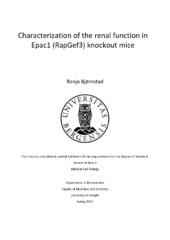| dc.description.abstract | The discovery of the exchange proteins directly activated by cAMP (Epac) has renewed our knowledge of intracellular cAMP signaling. The Epac1 isoform (RapGef3) shows high expression level in the kidney. In vitro studies have suggested multiple roles for Epac in the renal function. The development of an animal model were Epac1 is knocked out (Epac1-/- mice), however, allows for in vivo studies on Epac1 possible renal functions. In the present study Epac1-/- mice were compared to their reference wild type (WT) littermates, during baseline conditions as well as after per oral water load with and without presence of the antidiuretic vasopressin analog desmopressin. Under these conditions we measured renal excretion and/or clearance of creatinine, osmolytes, electrolytes, urea, cAMP and albumin. It turned out that Epac1-/- mice showed a normal ability to dilute their urine; Urine osmolality after water load combined with intra-peritoneal saline injection was 232 ± 14.90 in WT and 249 ± 7.377 in Epac1-/- mice. However, the effect of desmopressin on urine osmolality was significantly attenuated in Epac1-/- mice; Urine osmolality after water load and desmopressin was 598 ± 88.37 in WT and 443 ± 33.52 in Epac1-/- animals, with the increase (desmopressin relative to saline) being 163 % in WT and 77 % in Epac1-/- mice. The present study showed that a reduced response to desmopressin could not be explained by under-expression of either the AVP-stimulated urea transporter UT-A1 or the water channel AQP-2. A possibility is that Epac1 is required for optimal trafficking of AQP-2 to the apical membrane. Moreover, creatinine clearance, used as an estimate of glomerular filtration rate, was significantly increased in Epac1-/- mice following water loading (WT; 397 ± 44.98 µl/min vs. Epac1-/- 550 ± 19.52 µl/min). This difference in was not seen after treatment with furosemide (WT; 553 ± 121.9 µl/min vs. Epac1-/- 606 ± 64.01 µl/min), which blocks the Na+ -K+ -2Cl- co-transporter, and thus the tubulo-glomerular feedback response on vascular tone in the afferent arteriole. Urine and plasma analysis demonstrated no difference in the fractional clearance of osmolytes, creatinine, Na+ , K+ , and urea between WT and Epac1-/- animals. Epac1-/- mice did not demonstrate any sign of proteinuria, suggesting an intact glomerular filtration barrier. We conclude that renal functions are generally well preserved in Epac1-/- mice. These mice do, however, exhibit a moderate polydipsia and polyuria due to a perturbation of the effect of vasopressin on tubular water reabsorption. A role of Epac in the regulation of GFR at the level of macula densa is also suggested. | en_US |
